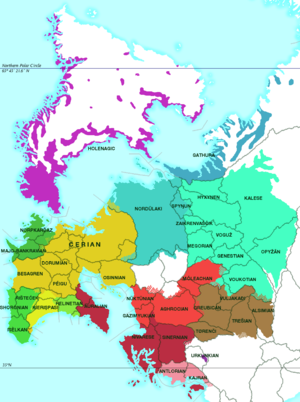Evandorian languages
| Evandorian | |
|---|---|
| Created by | – |
| Geographic distribution | planet of Calémere: most of the continent of Evandor, then in almost all of the planet |
| Linguistic classification | One of the world's primary language families
|
| Proto-language | Proto-Evandorian |
| Subdivisions |
|
The Evandorian languages (Cer.: sérešu Évandorion; Nor.: zarkor Evandóran; Aur.: linurï Evendörenh) are one of the language families of the planet of Calémere, the largest in terms of native and, most notably, second-language speakers. As the name says, the Evandorian languages are native of the continent of Evandor, one of the "continental areas" of the landmass called Greater Evandor (Sémánton Évandó) in Cerian sources, more commonly divided in the three continents of Evandor, Márusúturon, and Védren. All major languages of the continent are Evandorian languages, and, as Evandor was the birthplace of Western Calemerian civilization, Evandorian languages have had a large impact first on neighboring language and, in the last 700 years, on the whole planet due to exploration and colonization. Íscégon and Ancient Nivarese were the languages of the two main ancient Evandorian civilization and still prestige languages today, while the languages of the colonial powers (Cerian, Nordulaki, Auralian, modern Nivarese, and Dorumon above all, but also others) are spoken and understood in many areas of the planet; Cerian is possibly the most important trade language today, as the lingua franca of the Western world (opposed to Chlouvānem, the Eastern world's lingua franca).
Classification
Evandorian languages are divided in six major branches and two other languages — their names are mostly geographical — † denotes extinct languages:
- Northern Evandorian
- Central Evandorian
- Western Evandorian
- Xend languages
- Norpkarďaz
- Majo-Bankravian
- Shoronic languages
- Shoronian
- Rištećek
- Pevân †
- Isèlkan
- Helinetian
- Xend languages
- Southern Evandorian
- ancient Nivarese †
- modern Nivarese
- Auralian
- Gazimyük
- Agrôkian languages
- Gamurt †
- Agrôkyoň
- Móleachan
- Teñl Móleachan
- ancient Nivarese †
- Kegdevian languages
- Northern Kegdevian †
- Southern Kegdevian †
- Vuljakađi
- Kajran
- Narenian languages
- Megorian
- Spāq †
- Avathian
- Ëgusic
- Menbörük
- Holenagic
- Urkunkian (often considered a group of two different languages, usually called North and South Urkunkian as almost every town gives it its own name — both are spoken in Olymagù, one of only seven[1] countries in Evandor whose official and majority language is not an Evandorian one)
Writing
There are three different scripts in use for Evandorian languages:
- Most languages in the family use an adapted variant of the Íscégon script: such languages include all of the Western and Central branches plus Holenagic (isolate among the family), Nordûlaki, Spyŋun, Hyxynen, and Gathura (all Northern), Auralian and Gazimyük (Southern) and, since the last fifteen years, also Menbörük and Avathian (both Narenian languages).
- The Nivarese script is mainly used in the southern part of Evandor, and is the writing system used for Nivarese and the Agrôkian languages (all Southern), the Kegdevian languages, and Megorian (a Narenian language).
- The Véraj script, originally an offshoot of the Nivarese script, is used for the Landward Velken languages (except Hyxynen) and Ëgusic (a Narenian language).
Notes
- ^ 40% of Rūfīyya is not in Evandor, but most of its population is.
